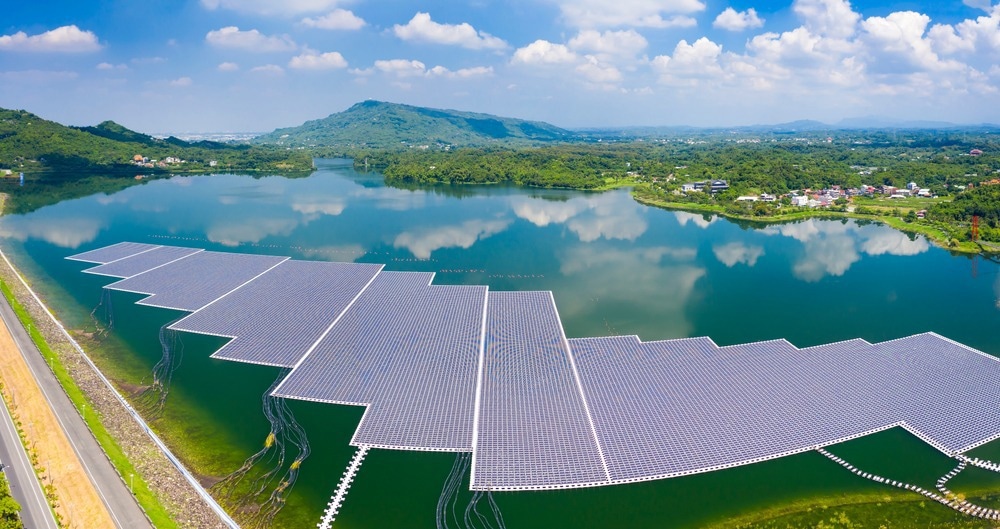Finding space for industrial-scale solar power arrays is a challenge for many countries aiming to significantly scale up renewable power capacity to meet net-zero carbon emissions targets. As a result, floating solar panel system use is increasing. In the Netherlands, this technology has been combined with solar tracking systems to produce a floating solar array that follows the sun for maximum efficiency throughout the day.

Image Credit: Tom Wang/Shutterstock.com
The floating solar panel island, Proteus, is located in Oostvoornse Meer, a southwest Netherlands lake. The floating structure is covered in 180 solar panels whose total installed capacity is 73 kilowatts of peak power (kWp).
The company behind the installation, Portugal’s SolarisFloat, argues that this small deployment could be scaled up to generate significant amounts of renewable electricity without demanding valuable land space.
Introducing solar tracking capability to floating solar arrays is SolarisFloat’s unique contribution to the field, with no other commercial floating array using any solar tracking technology to date. This is likely due to the significant mechanical complexity involved. While land-based solar tracking systems have the ground to anchor to and resist mechanical drive passively, Proteus has to use propellers to remain stable.
Ho SolarisFloat says that combining floating and solar tracking technologies means that Proteus is up to 40% more productive than comparable static installations on land. Proteus is a pilot project that SolarisFloat is using to test its cutting-edge technology and analyze its capacity to produce clean energy. The prototype was recently recognized, with SolarisFloat being nominated as a finalist in the European Inventor Awards in 2022.
The single-sided panels on the prototype rotate every few hours on two axes. They use mechanical, geospatial, and light sensors to determine the sun’s location in the sky, with motors and propellers employed to tilt the solar panels perpendicular to sunlight’s incidence.
Floating Solar Arrays
Floating solar arrays are becoming increasingly prevalent worldwide. Capacity from floating solar has grown significantly in recent years, from 70 MWp in 2015 to 1,300 MWp in 2020. The market for floating solar technology is growing at a CAGR of 43% and is expected to reach $24.5 billion annually by 2031.
As a relatively new option for renewable energy, floating solar has yet to be widely adopted, but its potential is vast. Suppose only 10% of all man-made reservoirs were covered with floating solar. In that case, the world’s electric grids could benefit from 20 terawatts of renewable power – 20 times more than today’s total solar power capacity.
Most of today’s solar power capacity comes from land-based solar installations, but unused land is becoming increasingly scarce. Land occupancy is a key criticism for conventional solar power, as it prevents land from being used to grow crops or carbon-sequestering trees.
Research has found that solar power needs up to 50 times more space than coal and up to 100 times more space than gas to produce comparable energy levels. The land use requirement for solar may also harm biodiversity, particularly in bio-rich areas inhabited by several important species.
Floating solar arrays are emerging as a useful solution to this challenge. Singapore and Japan are heavily invested in floating solar due to the scarcity of available land in those countries.
Floating solar also solves another problem of land-based solar panels: overheating. Solar panels become less efficient when they become too hot, but floating solar panels are cooled by the water beneath them and can generate more electricity. Production is improved by as much as 15% when comparable solar panels are placed over water due to the water’s cooling effect.
Floating solar technology also improves water supply, especially in very hot locations. This is because covering water sources reduces evaporation and prevents toxic blue-green algae blooms from growing and spreading. According to one study, floating solar panels on a reservoir in Jordan reduced evaporation by 42% while generating 425 MWh of electricity each year.
Less than 1% of all solar panel installations are floating. This is primarily due to technical and financial challenges – engineers know that putting anything on water exponentially increases mechanical complexity, introduces new constraints, and inevitably results in higher costs.
Solar Tracking Technology
Tracking technology is also under development and partially used in the solar industry. Tracking systems turn solar panels so that the incidence angle of the sun is minimized, where they are maximally efficient.
Double-side solar panels with solar tracking could increase energy production by 35%, reducing the localized cost of electricity by 16% compared to conventional, static solar systems. The market for solar tracking technology is expected to grow at a 16% CAGR in the 2020s.
Solar tracking is most important in Earth’s northern and southern latitudes, where the sun’s incidence angle is more significant. Tracking is often unnecessary near the equator as sunlight hits the ground closer to perpendicular.
Like floating solar, solar tracking increases initial and ongoing solar installation costs. However, these technologies' efficiency gains arguably make such additional investments worthwhile.
References and Further Reading
Aswati, A., et al. (2020). Review on sun tracking technology in solar PV system. Energy Reports. doi.org/10.1016/j.egyr.2020.02.004.
Exley, G., et al. (2021). Floating photovoltaics could mitigate climate change impacts on water body temperature and stratification. Solar Energy. doi.org/10.1016/j.solener.2021.01.076.
Gerretsen, I. (2022). The floating solar panels that track the Sun. [Online] BBC. Available at: https://www.bbc.com/future/article/20221116-the-floating-solar-panels-that-track-the-sun (Accessed on 24 November 2022).
Floating Solar Photovoltaic on the Rise. (2021) [Online] IFC. Available at: https://www.ifc.org/wps/wcm/connect/6ef92aa8-bf29-4c43-8edc-a0f7555e6a5d/IFC-EnergyNotes-FloatingSolar_WEB.pdf?MOD=AJPERES&CVID=n8KDCtS (Accessed on 24 November 2022).
Logiuratto, E. (2016). Brazil uses dammed lake surface for floating solar panels. [Online] Phys.org. Available at: https://phys.org/news/2016-03-brazil-lake-surface-solar-panels.html (Accessed on 24 November 2022).
Disclaimer: The views expressed here are those of the author expressed in their private capacity and do not necessarily represent the views of AZoM.com Limited T/A AZoNetwork the owner and operator of this website. This disclaimer forms part of the Terms and conditions of use of this website.